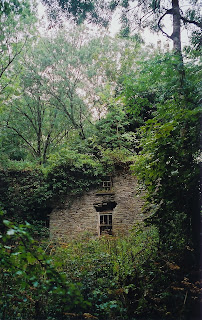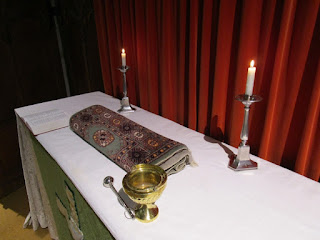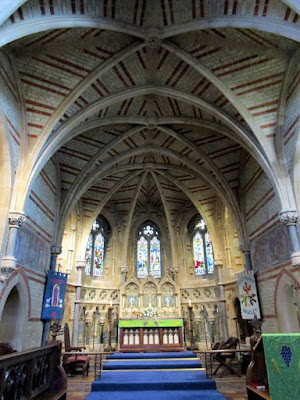As a distraction from current events, though we could discuss those and their resonances for a long while and may well yet, here is an offering from a different world. A couple of weeks ago our friend Dr Catherine Spooner was in the Netherlands – s’Hertogenbosch, to be exact, at the Den Bosch Design Museum – to talk about their exhibition ‘Designing Darkness’, which examines something we have long been interested in: the links between the Goth world and the wider Gothic tradition of which it is a part. Catherine took part in two discussions: the first, a two-hour marathon chaired by Ama von Dantzig (hard to know how to characterise her: ‘cultural and development researcher and organiser’ might be a summary) and involving a number of other speakers; and the second, a one-on-one conversation with curator Tomas van den Heuvel. Here they are, should you want to look them up.
The participants in the longer talk, apart from Dr Spooner and the two ‘official’ speakers, were academic Nick Groom from the University of Macau, though joining from his house on Dartmoor; Trae and Dani Ashes who run Goth podcast ‘Cemetery Confessions’, from the US; Mel Butler (who we’ve met before) from Yorkshire; and, in person, Lisa der weduwe from the Museum of Youth Culture in London. The talk covered four broad areas – ‘Goth and the ‘80s’, ‘Victorian Gothic’, ‘Belonging’ and ‘The Future of Gothic’, which seemed a bit arbitrary to me and which certainly strayed all over the place from their appointed limits, but also came up with all sorts of interesting thoughts and insights. The interaction between Goth and Gothic was a constant theme, illustrated when Nick Groom called attention to his S.O.P.H.I.E. lanyard – the campaign group set up in the name of murdered Goth Sophie Lancaster.
In
the first section, Lisa der weduwe
described the Goth-related photos in her museum’s collection, and its appeal
for further information related to the experiences of first-wave Goths, while
Dr Groom gave his memories of actually being there – a very individual experience,
as he remembered it, mediated by fanzines and tape-swapping rather than attending
venues which later became mythically famous: it was more than ‘a few tiny clubs
in London or Leeds’. It’s a different story from the one that usually gets
told. Mel Butler, on the other hand, described actually moving to Leeds in
order to join the Goth scene there, and finding that she’d found her ‘tribe’, a
place of safety. Dr Spooner then commented on the worldwide spread of Goth, and
the development of specific local forms. The discussion on ‘Victorian Gothic’
elaborated on the genre’s history (not just ‘Victorian’, in Catherine’s
account) and the role of literature, including Gothic’s ability to filter the
ambiguities of empire and progress.
The discussion of ‘Belonging’ brought in Trae and Dani who waxed very philosophical. It was here that we got into the knotty and interesting area of identity and the way Goths’ self-conception is changing. The two podcasters pointed out that while Goths in the ‘90s tended to conceive of their sense of identity in ‘essentialist’ terms – that Gothic was something you felt inside and then externalised – they now tend to think of it as something more performative and complex: ‘interior and exterior in a constant conversation … constantly bringing forth through bundles of objects and interactions’. As they pointed out, this exactly parallels shifts in the politics of gender and sexuality, which is both fascinating and yet, at the same time, only what one might expect. As for ‘The Future’, everyone talked about the dynamic potential of Goth and Gothic (despite, perhaps, the small numbers of actual Goths there are about at the moment). In response to the question whether Goth had lost its radical edge, Dr Spooner argued that this depended entirely on context: there were plenty of settings where Gothic affinities still, and always would, present a challenge to established and complacent understandings and authorities.
For
her one-to-one with Tomas van der Heuvel, Catherine sat at a table spread with
copies of her books (which we have talked about on occasion) and elaborated on
some of the themes of the earlier discussion. Pressed for a definition of the
Gothic, she deferred to her old tutor Chris Baldick, who stated that every
Gothic novel expressed three aspects: ‘claustrophobic enclosure in space, and
fearful inheritance in time, developing into an increasing descent into disintegration’,
and made reference to the ‘travelling tropes’ of Gothic identified by Roger
Luckhurst which we have only just discussed here. They talked about the exhibition
itself and agreed that the question ‘But is it Goth?’ helps you ask and answer
other questions, and Catherine complimented the inclusion of commercial Goth schmutter,
as well as the high-end designer-wear and handmade clothing and accessories
that such displays usually concentrate on. The fakery of Gothic, Gothic camp, the
growing influence of folk horror on Gothic (I recently discovered completely by
accident that Catherine has been writing for Hellebore, a folk horror journal I
bought as a result of reading about the Hexham Heads – but that’s another
story) and mutations of Gothic that focus on the future, all made an appearance;
as did Catherine’s next project, an account of the white dress in Gothic. If that
book ends up including PJ Harvey’s white
Chalk dress, now in the V&A, you will have to blame me …


































